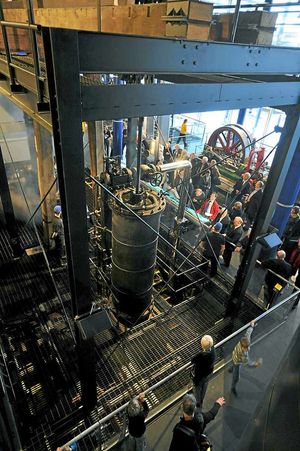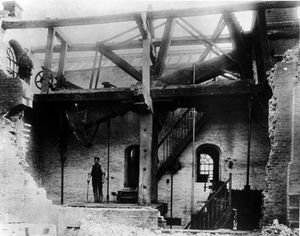Video: Heritage award for pioneering Smethwick Engine
It is the oldest working steam engine in the world, helping ignite the earliest days of the industrial revolution.




The Smethwick Engine was at the heart of the transformation of Birmingham at the start of 18th century, pumping enough water up the city's main canal to allow a flow of more than 200 narrow boats packed with materials heading in and out the area.
It has now been awarded an Engineering Heritage Award by the Institution of Mechanical Engineers – only the 92nd engineering artefact to be given the award since the organisation was set up 30 years ago.
The ground-breaking engine, thought up by inventor James Watt , blended the force of steam and a pressure vacuum to haul 1,500 buckets of water up the Birmingham Canal every minute.
James Watt worked in partnership with industrialist Matthew Boulton.
Installed in 1779 in Rolfe Street, Smethwick, the new system provided a solution to replenishing water levels at the top of six locks at Brasshouse Lane, by taking up water from the canal at Bridge Street.
Unveiling a plaque, John Wood, chairman of the institution's engineering heritage committee, said: "This made a major improvement to the amount of traffic that could use the canal.
"The engine also demonstrates the inspiring vision of people like James Watt, who made the industrial revolution possible."
He added: "The Smethwick Engine is not only the oldest working steam engine in the world today, but it was also a major step change in the technology of the steam engine in those early days of industrial revolution.
"It was the first engine in the world to use both the expansive force of steam and a vacuum at the same time.
"As an engineer, I always marvel at how they actually built an engine like this. Casting and machining the main cylinder of a beam engine would not be undertaken lightly today. Roads were anything but good then and heavy haulage primitive to say the least.
"And then, once you had got these massive pieces of timber and ironwork on site, erecting them would have been a huge challenge."
After 112 years in action, the engine was finally replaced and moved to preservation at the British Waterways Ocker Hill depot. Fast forward another century and it is now standing as the oldest working steam engine in the world at the Thinktank science museum in Birmingham.
It still has the original wooden rocking beam and condenser it had when first built.
The steam cylinder and valves have been replaced three times.
John Andrews, collection adviser at Thinktank, said: "The problem with the canal was there was not enough flowing water at the top of the locks – so it took great effort to replace water levels and limited boats going through.
"This engine solved the problem, it pumped enough water up to allow the flow of boats. The design of blending the vacuum and steam pressure in the same engine was before its time, the actual theory behind it was not known for another 100 years."
He added: "We're proud to have the engine here, and I'm pleased it has been given this award."
The engine was based on Mr Watt's design from 1769.
The vacuum inside it was created by a separate condenser and made it more efficient, generating a more powerful force than other engines at that time. Originally, it was one of two engines used to pump water back up to the 491ft summit of the Birmingham Canal Navigations Old Main Line.
The engines were built because there were insufficient water supplies to operate the six locks either side of the canal's original summit.
In 1892, a replacement engine was built in a brand new pumping house – now Grade II listed – next to Brasshouse Lane.
The original Smethwick Engine was then removed to British Waterways' Ocker Hill depot until it was bought by Birmingham City Council.





